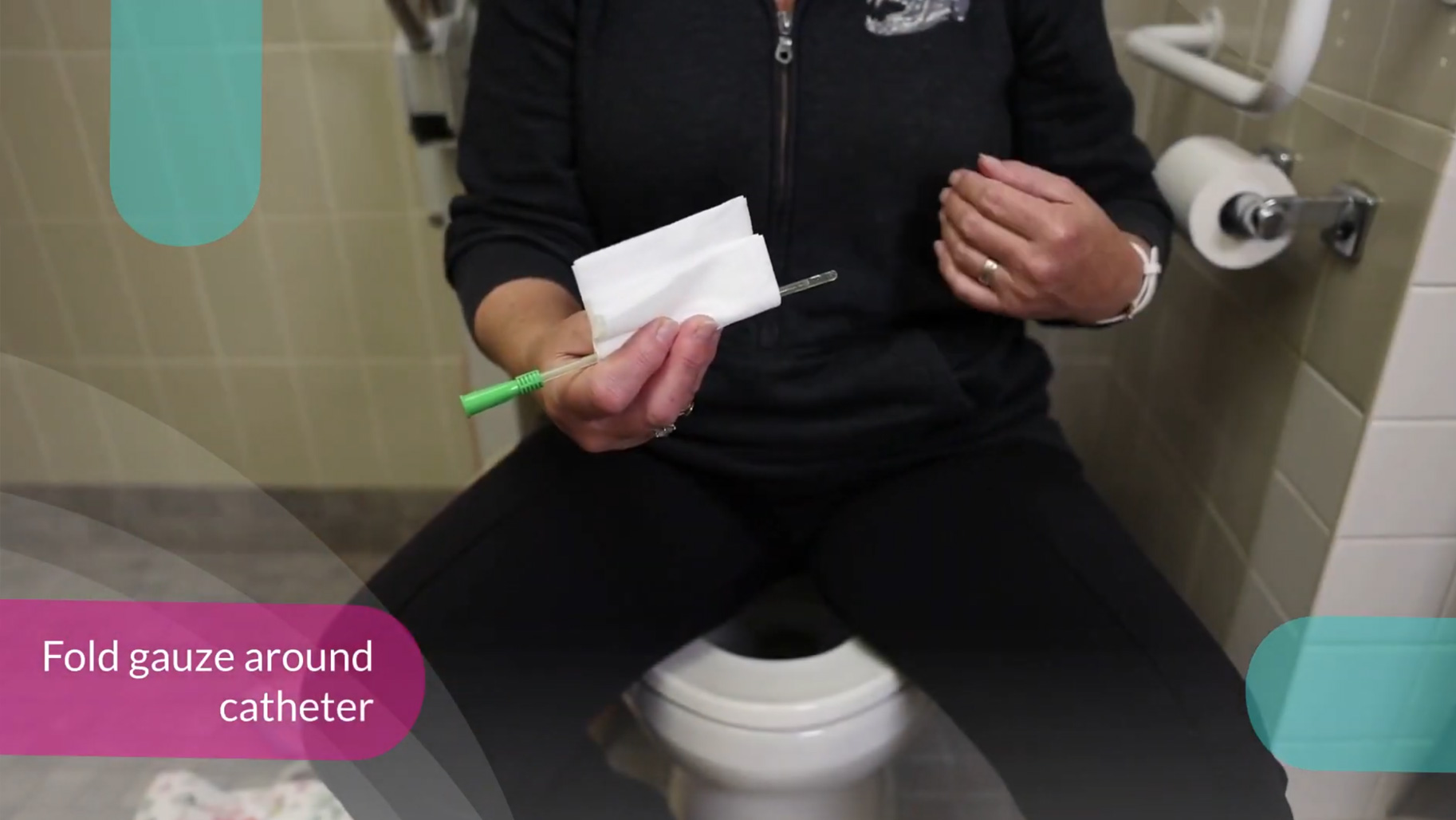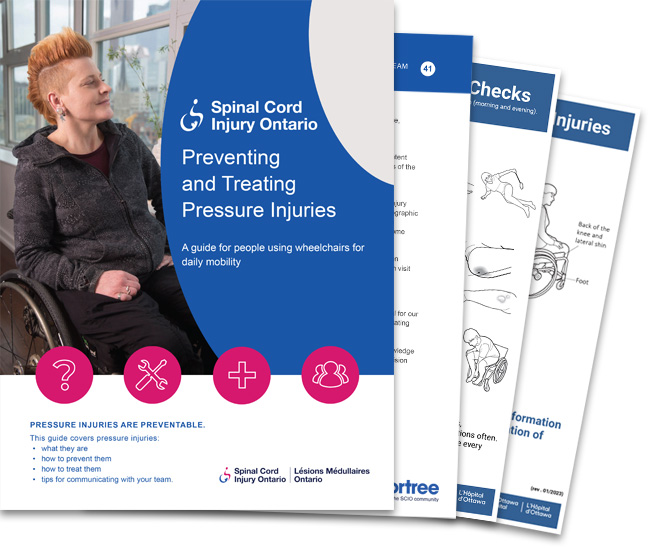This video demonstration will introduce you to a first-person point of view of self-catheterization with the person sitting up in bed. This is a demonstration of how one person does self-catheterization. Because everyone is different, your level of function and ability, as well as input from your healthcare team will help you determine what works best for you. This video series and these demonstrations are intended to supplement the direction and ongoing support provided by your healthcare team.
First, always try to ensure you’re using a clean environment with clean surfaces before you position yourself. Place a clean catheter and all the needed supplies within reach of the bed’s edge. This can include: gloves if used, a catheter, lube, baby wipes or alcohol-free cleansing wipes, a blue pad or soaker pad, a mirror if you use one, and a urinal or urine collection container.
Once the supplies are ready and you place the blue incontinence pad on the bed you’ll transfer yourself over. Once on the bed you can shimmy side to side to remove your pants and underwear, removing one leg at a time.
Now you’ll raise the head of the bed into the sitting position. At this point you could line up the blue incontinence pad under yourself or fix any wrinkles in it. Position your legs, with your knees pointing out and feet facing in. People whose spinal cord injury is new to them may be using incontinence briefs with pull tabs. If you are wearing these, not regular underwear, you would put the blue pad on top of the incontinence brief so the brief doesn’t get wet.
Once you’re in position lay the mirror and collection container close to your pelvic area. At this point you may need to shimmy yourself into a better position to be able to access the mirror and container while still being able to see yourself in the mirror.
Now that you’re ready to open the catheter make sure to put on your gloves first. Open or prep the wipes. Now you’ll open the catheter wrapping and lube the catheter. Using one hand, you would now spread the labia. Using the wipes, clean the area using a front to back motion, once to the left once to the right, once in the middle, and using a new wipe each time.
Keeping the labia open if possible, pick up the catheter and remove it from the open package. Using the mirror guide the catheter toward the urethral opening. Insert the catheter until the urine begins to flow, and then insert it another 1 to 2 cm, but no further. Once the urine flow stops pull the catheter out, little by little to empty the remaining urine. Then pinch the catheter to stop the flow from going back up the catheter and remove it.
Now you can wrap the catheter up in one glove and use the other glove to pick up all the trash, and use it to wrap the glove the catheter’s in. Do a final wipe from front to back to remove any remaining lubrication. Place any remaining trash in the glove, then transfer everything back to the bedside table.
Now you straighten your legs and pull your pants up to where you can reach them when lying down. Then put the head of the bed into the flat position and roll side to side to pull your pants all the way back up. Then transfer back into your chair, empty the urine container, and throw out the gloves.
Remember, after you get urine flow insert the catheter another 1 to 2 cm more, unless you feel any resistance. If you ever have any questions or concerns about catheterization reach out to your healthcare team.
We would like to acknowledge and thank the people with lived experience who contributed their insights and tips to the development of this video series:
- Lubna Aslam, former Spinal Cord Injury Ontario staff
- Jaspreet Dhaliwal, Peer Support Program Coordinator, Spinal Cord Injury Ontario
- Michel LeFeuvre-Watson
- Jacqui Kinahan, Peer Support Volunteer, Spinal Cord Injury Ontario
- Nancy Xia, Video Content Developer, Spinal Cord Injury Ontario
- Julie Watson, Peer Support Program Coordinator, Spinal Cord Injury Ontario
We would also like to thank UHN Toronto Rehab – Lyndhurst Centre staff who provided clinical subject matter expertise, source content and expert review of this video series:
- Sandra Mills, Patient Education and Engagement Lead, UHN – TRI Lyndhurst Spinal Cord Rehab Program
- Hannah Hollett, Clinical Coordinator Intrathecal Baclofen Program, UHN – TRI Lyndhurst Spinal Cord Rehab Program
- Dr. Cathy Craven, BA, MD, MSc, FRCPC, FASIA. Physical Medicine and Rehabilitation, Toronto Rehabilitation Institute Chair in SCI Rehabilitation; Medical Director , Spinal Cord Rehabilitation Program, UHN; Senior Scientist, KITE Research Institute, University Health Network; Professor, Department of Medicine, University of Toronto.





